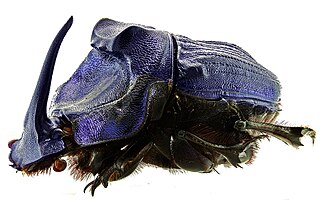
The scarab beetle subfamily Scarabaeinae consists of species collectively called true dung beetles. Most of the beetles of this subfamily feed exclusively on dung. However, some may feed on decomposing matter including carrion, decaying fruits and fungi. Dung beetles can be placed into three structural guilds based on their method of dung processing namely rollers (telecoprids), dwellers (endocoprids) and tunnelers (paracoprids). Dung removal and burial by dung beetles result in ecological benefits such as soil aeration and fertilization; improved nutrient cycling and uptake by plants, increase in Pasture quality, biological control of pest flies and intestinal parasites and secondary seed dispersal. Well-known members include the genera Scarabaeus and Sisyphus, and Phanaeus vindex.

Deltochilum valgum is a nocturnal, Neotropical species of dung beetle in the family Scarabaeidae, which has evolved a predatory lifestyle. While most other members of the true dung beetle subfamily feed on faeces or decomposing matter, D. valgum is highly specialised for eating millipedes; such a transition from scavenger to carnivore is rare. Whether this is novel adaption in this species or an ancestral adaption in the genus is unclear; at least two other species, Deltochilum kolbei and D. viridescens, which are not particularly closely related to D. valgum, also kill and feed on millipedes.

Heliocopris is a genus of Scarabaeidae or scarab beetles in the superfamily Scarabaeoidea. Forty-seven of the fifty-two known species are found in Africa, but a few are found in southern and southeast Asia.
Gilles Terral was a French entomologist. He specialised in Lepidoptera Parnassiinae and Saturniidae.

Coprophanaeus ensifer is a large South American species of beetle belonging to the family Scarabaeidae.

Phanaeus, the rainbow scarabs, is a genus of true dung beetles in the family Scarabaeidae, ranging from the United States to northern Argentina, with the highest species richness in Mexico. Depending on species, they can inhabit a wide range of habitats, from tropical to temperate climates and deserts to rainforests. In those living in relatively arid places adults are primarily active during the wet season and those living in relatively cold places are primarily active during the summer. They are excellent diggers and good fliers.

Sulcophanaeus imperator is a brightly colored species of dung beetle belonging to the family Scarabaeidae. This diurnal, coprophagous beetle is native to south-central South America and generally common. It is paracoprid, meaning that adults dig tunnels into the soil under the food source and move parts of the food source to a nest chamber where the eggs are laid.

Oxysternon is a Neotropical genus of scarab beetles (Scarabaeidae) in the superfamily Scarabaeoidea. It can be distinguished from all other phanaeines and scarabaeine dung beetles by a long, spiniform extension of the anterior angle of the metasternum. Most species vary in color and pattern, and are more commonly found in tones of green, often infused with yellow or coppery highlights. All species appear very smooth or glassy smooth to the unaided eye.

Coprini is a tribe of scarab beetles, in the dung beetle subfamily (Scarabaeinae). Scholtz et al. describe them as tunnellers that are shiny black, of moderate to large size and with a strongly convex shape. They also, however state that the grouping based on these characteristics has little phylogenetic validity, and the placement of several genera in this and related tribes is likely to change.

Phanaeus difformis is a species of true dung beetle in the family Scarabaeidae that is native to south-central United States and adjacent far northern Mexico. It may hybridize with the generally more common P. vindex.

Phanaeini is a tribe of dung beetles in the family Scarabaeidae. There are about 12 genera and 200 described species in Phanaeini. They are native to the Americas with the highest species richness in the Neotropics. They are mostly coprophagous or necrophagous, but some of the least known genera appear to be myrmecophilous. They are medium-sized to large beetles, often with bright metallic colors, and often with horns on their heads.

Phanaeus adonis is a species of true dung beetle in the family Scarabaeidae, found primarily in north-central Mexico, but also ranging into Cameron County in far southern Texas, United States.

Ateuchini is a tribe of dung beetles in the family Scarabaeidae. There are at least 30 genera and 370 described species in Ateuchini.

Pseudocanthon is a genus of in the beetle family Scarabaeidae. There are about nine described species in Pseudocanthon.
Coprophanaeus pluto is a species of dung beetle in the family Scarabaeidae. It is found in Guatemala, Mexico and southernmost Texas ; it is the only species of Coprophanaeus in the United States. This black beetle feeds on carrion and typically is 1.8–2.8 cm (0.7–1.1 in) long.

Phanaeus triangularis, the black phanaeus, is a North American species of true dung beetle in the family Scarabaeidae. It is found in the eastern half of the United States.

Oxysternon conspicillatum is a species of dung beetle in the family Scarabaeidae. It is found in both evergreen and semi-deciduous mesic forests, including disturbed habitats, ranging from near sea level to an altitude of 3,000 m (9,800 ft) in the Amazon basin and Chocó of tropical South America and Panama, possibly extending as far west as the border region with Costa Rica. Both adults and young of this common and widespread beetle primarily feed on dung, but the species has also been recorded feeding on dead animals.
Ochicanthon ceylonicus, is a species of dung beetle found in Sri Lanka.
Ochicanthon cingalensis, is a species of dung beetle found in Sri Lanka.

Coprophanaeus lancifer is a large species of beetle belonging to the family Scarabaeidae. It is found widely in the Amazon rainforest in South America and it is often common.

















